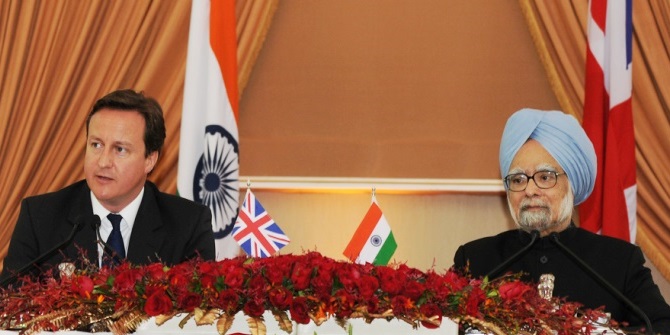 Is there a causal association between rising lethal violence and the policy context of austerity, as has recently been suggested? Anthony Ellis explains in what sense austerity may be an important piece of the puzzle of rising violence, alongside the effects of inequality, competitive individualism, and insecurity.
Is there a causal association between rising lethal violence and the policy context of austerity, as has recently been suggested? Anthony Ellis explains in what sense austerity may be an important piece of the puzzle of rising violence, alongside the effects of inequality, competitive individualism, and insecurity.
In the wake of the fatal stabbings of Jodie Chesney and Yousef Makki on 1 and 2 March 2019 respectively, Prime Minister Theresa May faced severe criticism after claiming that these, and other recent homicides, were not linked to government enforced cuts to police and youth services. To play down the significance of austerity was a deeply cynical political manoeuvre, but one that was to be expected. However, the issue of rising levels of serious violence in England and Wales is not solely about austerity, although it has likely played some role. Unfortunately, those looking for straightforward answers will not find any. The causes are numerous and complex.
Amid the media’s feast over this issue, a healthy dose of perspective is helpful. The UK does experience comparatively low rates of lethal violence when compared internationally. Like several other Western liberal capitalist nations, recorded rates of homicide in the UK have declined steadily across history. This decline has been punctuated though by periods of increased violence and disorder, often during times of economic change, largely concentrated in particular geographical areas and amongst particular groups. Comparatively low rates of British murder currently, despite the recent rises, are not an excuse for individualising this issue though and analysing it in isolation from the social, political and economic context that envelops it.
Considerable evidence suggests that violent behaviour is likely to increase during times of social change and economic difficulty. Stark warnings were issued by the Home Office in a letter to Downing Street in 2008 suggesting that the recession would generate a socially toxic atmosphere of increased hostility and violence. As the years went by though reported violence rates continued to decline as they had been doing since around the mid 1990s, leaving many criminologists scratching their heads. It was not until 2015 that recorded rates of homicide began to increase. The considerable gap between the beginning of the recession, the implementation of austerity, and rising rates of violence, does raise some important questions about the nature of the association between these factors. It certainly does not diminish the potential influence of the cuts, in the cynical fashion that Theresa May has claimed. Nevertheless, the gap in time appears to have created just enough ‘wriggle room’ for politicians to defend austerity.
Austerity has some potential association with contemporary rates of violence, but what criminologists must try to understand better is the specific nature of that relationship. So far, the discipline has allowed the debate to be taken up by the media and politicians. This is perhaps, as I have argued elsewhere, due to contemporary Criminology’s lack of engagement with aetiology – the causation of crime. A difficult but important issue to consider, is whether rates of murderous violence have changed because cuts to services designed to maintain public order and social inclusion have generated greater opportunities to be violent. This would infer that given the chance – in the classic Utilitarian philosophical sense – individuals will act on opportunities presented by diminished social controls on their behaviour and the reduced prospect of being caught and punished. Or, are these rises the result of the mediated effects of social and economic conditions that affect the desire and motivation of some groups to violently harm others?
Danny Dorling helpfully reminds us that murder rates are a ‘social marker’ that tell us ‘the story of the connected consequences to our collective actions’. By this he means that changing economic circumstances and the political decisions that inevitably follow, have consequences that filter down not just to the man wielding the knife, but through those that are behind him:
the man who sold him the knife, the man who did not give him a job, the man who decided that his school did not need funding, the man who closed down the branch plant where he could have worked, the man who decided to reduce benefit levels so that a black economy grew.
In the haste to acquire straightforward answers to these latest rises, these kinds of various consequences and their complex mediated impact upon those doing the killing, and who are being killed, have remained largely hidden from view during the debate.
Despite its wealth, contemporary Britain is highly unequal, and economic inequality distributes the risks of violence unequally amongst the population. A brief look at the most recent data compiled in the Home Office’s Homicide Index for 2017-2018, reveals that these latest rises in the homicide rate are most pronounced in male victims and those aged between 16-34. Data on convictions during this same period tells a similar story, with over half of those convicted being male and aged 16-34. It is poorer men of this age group in particular that are now most at risk of being murdered and specific men within this same group who are most likely to engage in violence persistently. This clear trend in contemporary British murder can be traced to changes in the country’s economic and political systems during the 1970s and 80s, which had profound and lasting effects.
The varied consequences of economic changes and political decisions gradually rendered considerable numbers of the British working class economically obsolete, while consumer lifestyles, commodities and the general trappings of wealth and privilege enjoyed by some became more obvious to all. The defining and lasting mantra of this period emphasised the importance of individuality, the ability to compete, to be self-reliant, and that if you fail to succeed it is your own fault, not society’s. Inequalities in wealth have continued to grow since then. While the simultaneous exclusion of considerable numbers of poorer groups, not just in the UK but across the world, from global capitalism’s production processes, has become a defining issue of the contemporary period.
Despite their evident exclusion, the groups of younger men that are engaging in serious violence and other criminality remain attached to the powerful appeal of consumerism, material wealth, and their ability to imbue social status, inspire envy in others, and signify prestige. In poorer neighbourhoods and old industrial areas, consumerism and competitive individualism have melded with traditional masculine prerogatives around mental and physical toughness that were once economically functional to an economy that relied on heavy industrial production. Some disadvantaged men who engage in serious violence today are invariably subjected to a ‘toughening up’ process that instils a deep fear of humiliation and positions violent potential as an individualised means of protection, gaining social status, and defending reputation. Male violence is very often about the avoidance of humiliation and an attempt to escape into a state of pride by responding to perceived challenges from others, or reacting aggressively to being disrespected.
Contemporarily, austerity has created a void where previously services had greater resources to address issues of order maintenance and the social integration of individuals. This is potentially an important piece of the puzzle of rising violence. Other important pieces seem to be the effects of inequality, as well as competitive individualism, insecurity and traumatic biographies; a toxic concoction that underlies the kinds of contests over personal reputation and social status that are resulting in the increased deaths of largely younger, insecure, poorer men. It is the fusion of these various pieces that potentially constitutes the puzzle of the incline of lethal violence in post-recession austerity UK.
_____________
Note: the above draws on the author’s published work in the British Journal of Criminology.
 Anthony Ellis is Lecturer in Criminology and Sociology at the University of Salford.
Anthony Ellis is Lecturer in Criminology and Sociology at the University of Salford.








2 Comments